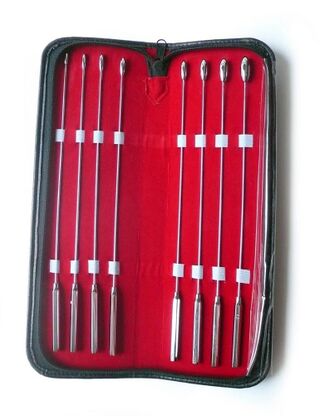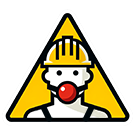Urethral play
| Other names | Catheter play, Sounding |
|---|---|
 | |
| A set of rosebud sounds, from 3-10 mm in diameter | |
| Health risk | Moderate |
| Legal risk | Low (varies by region) |
Urethral play, including sounding and catheter play, involves the insertion of objects into the urethra for sexual stimulation. The urethra is the tube that allows the body to release urine, and in many men, semen. The urethra is very sensitive to tactile stimulation, and can be easily injured or become infected. Therefore, a clear understanding of the risks and performance of careful technique are essential to avoid unwanted complications.
Background
Urethral play has historical roots in both medical procedures and fetish communities. For example, the term “sounding” originates from medical instruments called “urethral sounds”, which were once commonly used to dilate or explore the urethra to treat a number of urological conditions.
Appeal
- Urethral stimulation can provide extremely intense novel physical sensations in which many people experience elements of both pain and pleasure.
- These sensations can be further intensified using insertables with varying textures, longer depth, wider diameters, or combined with other modes of stimulation like vibration or Electrostimulation.
- Some participants find the sight and/or sensations of an object penetrating the urethra to be extremely psychologically powerful, often evoking considerable anxiety and fear responses.
- Some forms of urethral play can also be used to control of the release of urine or semen, causing some overlap with other kinks such as bladder control or orgasm control.
Methods
Sterility
All objects to be inserted in the urethral should be reasonably sterilized. For extremely smooth, clean materials (i.e. without crevasses or adhered debris), an alcohol wipe may be sufficient. Other materials may require more advanced methods such as autoclaving or UV light treatment.
Sterile technique takes practice, and involves developing a very strong mental map of what equipment, surfaces, gloves, hands, etc. are sterile and what are not, and the situational awareness to detect if something nonsterile touches something sterile (rendering it also nonsterile).
For scenes intending to leave an insertable in the body for a prolonged period of time, or more complex scenes involving multiple steps and pieces of equipment, practitioners should wear sterile gloves to maintain sterility. Often the "clean hand, dirty hand" technique is used, where one hand is kept completely sterile, and the other hand is used when touching something that does not need to stay sterile.
Insertion
Safely inserting an object into the urethral relies on tactile feedback from the inserter's hand, and requires understanding of the urogenital anatomy to interpret. For example, during insertion, points of increased resistance may be encountered. Depending on the anatomy encountered, the degree of resistance, and the sensations being experienced by the receiver, it may or may not be safe to proceed.
Sterile lubricant should always be used when inserting an object into the urethra. It is possible to use lubrication with local anesthetic to reduce insertion discomfort. However, using numbing lubricant increases the risk that injury could occur and/or be worsened because of the inability to feel sufficient pain that would otherwise abort the insertion. Slow, deliberate insertion is important, especially if the inserter is unfamiliar with the subject's anatomy.
Inserting into male anatomy, the object will enter the urethral meatus. Some people have some degree of restriction shortly after the meatus that may provide resistance to insertion. Once in the penis, the object should move smoothly until it enters the PC muscle and encounters the external urethral sphincter just before the prostate. This may provide additional resistance in which the subject may feel sensations that are similar to when they urinate. After this has been passed, the object enters the prostatic urethra, which produces a notably less sharp friction sensation, and instead becomes more dull and warm. Some people find stimulating this area to be particularly pleasurable. Finally, continued advancement will encounter the internal urethral sphincter which opens up into the bladder. As this is overcome, urine may start flowing uncontrollably either through the inserted device or around it in the urethra.
Equipment
Urethral sounds or plugs
Urethral sounds and plugs are often made of smooth metal, though other materials such as glass, silicone, or plastic can also be used.
Sounds are usually designed to insert deeper into the body, and can sometimes reach all the way into the bladder. As the sound passes through various anatomical structures, different sensations are produced.
Urethral catheters are soft tubes that are designed to pass all the way into the bladder. Some have balloons which can be filled with sterile water once in the bladder to keep the catheter in place.
Risks
- Infection: Bacteria introduced into the urethra can cause urinary tract infections (UTIs), prostatitis, or even systemic infections if severe.
- Urethral Injury: Tears, abrasions, or false passages can occur if excessive force or unsuitable instruments are used.
- Bleeding: Minor bleeding can be a sign of micro-trauma; significant bleeding warrants prompt medical evaluation.
- Stricture Formation: Chronic trauma to the urethra can lead to scar tissue and narrowing (strictures) over time.
Risk mitigation
Infection
- Sterile technique
- Thoroughly clean and disinfect sounds or catheters before each use.
- Use gloves and single-use sterile lubricant packets whenever possible.
Urethral injury
- Use Appropriate insertable equipment
- Avoid household objects; invest in body-safe medical-grade equipment.
- Ensure all surfaces are smooth and undamaged.
- Use sufficient lubrication and advance slowly. Try to use no more than the force of gravity to power insertion. Stop if significant discomfort occurs.
- Slow escalation
- Start with the widest sound you can insert with little discomfort or resistance
- Very small sounds can increase the risk of injury from being so pointed
- If desired, gradually increase to larger diameters with careful deliberate technique and clear knowledge of anatomy.
- Start with the widest sound you can insert with little discomfort or resistance
If pain significantly increases or bleeding occurs, stop immediately. Seek medical advice if symptoms worsen or persist.
Communication
- If playing with a partner, use a safe word or signal to halt the activity if discomfort escalates.
Known incidents
Medical case reports
- Unusual Fatal Mechanisms in Nonasphyxial Autoerotic Death
- Catheteroticum: Fatal late complication following autoerotic practice
